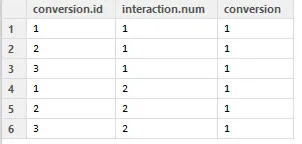我正在尝试使用melt公式将数据框从宽格式转换为长格式。挑战在于我有多个列名标记相同。当我使用melt函数时,它会删除重复列的值。我已经阅读了类似的问题,并建议使用reshape函数,但我无法使其工作。
为了重现我的起始数据框:
数据框的样子如下:
它删除了interaction.num == 2列,并且看起来像这样:
任何建议将不胜感激!
为了重现我的起始数据框:
conversion.id<-c("1", "2", "3")
interaction.num<-c("1","1","1")
interaction.num2<-c("2","2","2")
conversion.id<-as.data.frame(conversion.id)
interaction.num<-as.data.frame(interaction.num)
interaction.num2<-as.data.frame(interaction.num2)
conversion<-c(rep("1",3))
conversion<-as.data.frame(conversion)
df<-cbind(conversion.id,interaction.num, interaction.num2, conversion)
names(df)[3]<-"interaction.num"
数据框的样子如下:

melt.df<-melt(df,id="conversion.id")
它删除了interaction.num == 2列,并且看起来像这样:


任何建议将不胜感激!